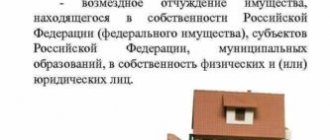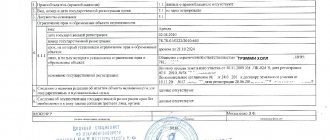Purpose of property inventory
The main purpose of the inventory is to document all property transferred for temporary possession to residents, so that at the time of their departure, everything described in the document will be returned to the owner in the same condition.
Otherwise, when something from the list is missing, broken or damaged, the tenant must compensate for the loss. It is also worth considering the condition of the apartment itself: covering the walls, floors, windows and doors. If the apartment is new and in good repair, then indicate this in the inventory. Include anything you value, even if it's fresh wallpaper or bathroom counters.
Document form
There are no strict requirements regarding the form of the document. It is allowed to compose in both printed and handwritten versions.
You can also fill out a pre-prepared form by hand or make amendments and additions to a printed one.
There is no need to certify the paper by a notary; once signed by both parties, they already acquire legal force.
The content is usually compiled by the owner. If the agreement is drawn up with the participation of a realtor, then he can also help in concluding the document.
Ideally, a list of everything that is in the apartment should be compiled on the day the keys are handed over to the tenant, during the signing of the main rental agreement. When registering property, both parties must be present - the owner and the tenant.
If the list was prepared in advance, then the parties need to check the authenticity of its contents on the day of the transaction.
This is, first of all, necessary for the tenant, since if the owner is unscrupulous, then on paper he can indicate a number of things that are not actually in the apartment.
After the transaction is terminated, he can thereby deceive the tenant by demanding compensation from him for the loss of missing items.
An inventory is a document containing a list of things transferred to the tenant along with the apartment under the lease agreement. Drawing up this annex to the contract is important for both the property owner and the tenant. This paper guarantees the owner the safety of his property.
If something in the apartment is damaged or lost when a tenant evicts, the owner has the right, on the basis of this document, to demand compensation from the tenant for the damage caused. The document also protects the tenant: the owner will not be able to make claims against him regarding the loss of things if they were not indicated in the inventory.
Also, the owner will not be able to demand monetary compensation for damage to a certain item if it was initially handed over for use with defects and malfunctions.
Who composes?
The document can be compiled in one of the convenient ways:
- The owner draws it up independently, after which, together with the tenant, on the day of signing the contract and handing over the keys, he double-checks the data specified in the inventory with the actual state of things and their quantity.
- The owner, together with the tenant, checks all valuables in the apartment and records them in the document. The tenant also has the right to include items in the apartment in the inventory if they were not listed by the landlord.
Features of drawing up an inventory of property assets
This document is drawn up in ordinary written form in two copies. It displays: passport data, full name, signatures of both participants, date of registration.
For the entire rental period of the housing space, such a Certificate is drawn up 2 times: immediately before entering the apartment, and before terminating this agreement. Before signing the document, it is necessary to carefully check all the property located in the apartment for integrity, exclusion from the inventory drawn up in the name of the debtor, for example, in the event of bankruptcy of a citizen renting out his own apartment, etc.
Important! If the condition of property assets when drawing up the second act does not correspond to the condition specified in the first document, the lessor has the right to make a statement to the tenant about the relevant claims.
Storage of property inventory
The inventory becomes an annex to the rental agreement, that is, an addition to the main document, or is drawn up as an additional clause in the agreement. Both options are appropriate, choose either one.
In addition to the property inventory form when renting an apartment, the rental document contains two acts of delivery and acceptance of residential premises. The first act is filled out by both parties when renting out housing, the second - when returning the apartment to the landlord.
The act of acceptance and transfer of housing is not included in the list of mandatory conditions of the housing rental agreement, but determines the moment of transfer of housing to the tenant and records the condition of the housing and things transferred by the landlord for temporary use and possession.
What to include in the inventory
There is no need to rewrite all the nails and forks in the document. But only the homeowner decides, and when a specific sample property inventory form is drawn up when renting out an apartment, it can include everything: from a light bulb to a door handle and tea cups in the kitchen.
It is quite problematic to compile such a detailed list, so lawyers recommend focusing on the following categories of property:
- Plumbing.
- Furniture.
- Appliances.
- Dishes.
- Elements of interior and decor.
- Type of finishing.
- Electrical devices.
- Counters and metering devices.
Let us repeat that simply listing things is not enough. It is necessary to record each item, its appearance, technical and physical condition, and suitability. It is not necessary to indicate the cost, but it is acceptable.
IMPORTANT! The owner has the right to establish a ban on the use of certain objects (equipment, electronics, etc.). For example, prohibit the use of expensive dishes or a computer.
Content
What is included in the description of housing for subsequent rental?
The list must include those items whose damage or loss would result in significant material damage.
Typically these include:
- furniture,
- Appliances,
- interior items,
- plumbing,
- lighting,
- metering devices,
- dishes.
The owner has the right to include items in the list at his own discretion!
Separately, it is possible to indicate the rules for using the transferred items - what is allowed/prohibited to do with it, requirements for use.
A general description of the condition of the housing is contained in the transfer and acceptance certificate; it should not be reflected in the inventory. The document must also contain information about the parties to the transaction - full name and passport details.
Collection of payment according to the inventory for damage to property
The lessor has the right to terminate the lease agreement and (or) demand compensation for losses if the tenant did not operate the leased property in accordance with its purpose.
The procedure in this case is as follows:
- the tenant informs the tenants about the existing damage;
- the lessor draws up a free-form damage report, which describes the damage, the causes and circumstances under which they occurred;
- the employer compensates for losses, the amount of which is specified in the act.
A little more detail on each point. It is in the interests of the tenant to report any defects that have arisen in the owner’s belongings, as this will help to quickly localize and eliminate the problem and, possibly, reduce the amount of damages to be compensated.
In addition, if we are talking about household appliances or furniture that the tenant uses every day, then it is better to report any faults immediately and resolve the issue of repairing or replacing the item together with the landlord.
Next, the owner of the living space draws up a damage report. Outside experts are involved in this process if the situation is controversial. But in any case, the landlord assesses the amount of damage independently.
Damage to property
Often cases of disputes between the owner of an apartment and tenants arise due to damage to property.
Such situations arise when:
- natural wear and tear - each item has its own service life. For example, a light bulb has burned out; it can be replaced by the tenants or the owner (by agreement). In the case of normal wear and tear, the tenant usually refuses to pay for the damage;
- damage due to careless handling or accident - for example, curtains breaking due to a fall or cleaning. If there was no serious damage, then the tenant may not compensate for the damage or independently return the item to its place (you can ask the owner or neighbors for the tool);
- intentional damage - occurs when the tenant is not satisfied with the terms of the lease and deliberately begins to damage things or steals property when moving out.
In any case, having an inventory in the contract and prescribing liability measures for use will protect both parties from possible disputes.
Having photos before moving in will help sort out any disagreements that arise.
In order not to bring the matter to court and proceedings, you can take out insurance for the property with the condition of using it for rental.
Level of detail
It is recommended to describe all items in as much detail as possible:
- quantity,
- appearance,
- manufacturer, year of manufacture (if known),
- defects,
- degree of wear.
You can also indicate the estimated value of the items being transferred. Note any, even the most minor, damage - cracks, chips, scratches.
In the event of damage or loss, it is the characteristics of the condition of the movable that will serve as the basis for calculating compensable losses.
We invite you to familiarize yourself with: Sample financial statement form
What does this annex to the agreement mean and why is it needed?
In general terms, the act of transferring an apartment during a lease means a document certifying the condition of the premises, as well as the property located in it, at the time of its transfer to the tenant for temporary use.
Thus, having in hand an act of acceptance of the transfer of real estate, containing information about its condition at the time of transfer under the lease agreement, the landlord will be able to recover compensation from the tenant for damage to property in the rooms after the return of the apartment (if this happens).
In turn, the tenant will be provided with protection from unfounded claims from the apartment owner regarding damage to property, which was already in poor condition at the time of concluding the lease agreement.
It is worth noting that at the legislative level the tenant and the landlord have no obligation to draw up an act of transfer of the apartment. This need arises in the case of the sale of real estate (Article 556 of the Civil Code of the Russian Federation).
The current legislation does not approve a single form of the document. At the same time, several general rules for its preparation can be outlined:
- Prepared in printed form. Writing by hand is also acceptable, but it will take a lot of time and is not very convenient.
- It is compiled in any form, taking into account the points that must be included in its content.
- The act is double-sided and printed in 2 copies. One will remain with the tenant, and the second will be given to the landlord.
- It is drawn up in the presence of both parties to the transaction, and the list of property is compiled by the owner of the apartment.
- Introductory part (“header”) - here it is stated that the drawn up act is an annex to the agreement (the date, month and year of its conclusion are indicated).
- The title of the document is the date of its preparation and the place where it was compiled.
- Content – this section consistently presents the following information:
- Link to the main agreement.
- Address of the rented apartment.
- A note about the presence of a telephone in the room indicating the number.
- Housing and communal services meter readings at the time of handing over the keys to the premises.
- A general description of the existing shortcomings of the living space.
- List of property transferred to the tenant for use under a lease agreement. This information can be reflected directly in the act or a separate inventory can be drawn up, which should, if possible, include all furniture and household appliances with a detailed description of their condition.
- A mark indicating that the property is suitable for habitation.
- A message about the fact of transfer of keys to the tenant, the amount of the security deposit (if such a condition is provided for by the terms of the lease agreement) and the number of copies of the act.
- The final section - both parties to the transaction must sign here. This is formatted as follows:
- First, the word “HANDED OUT” is written, indicating the date the keys were handed over to the tenant. Under this word the lessor must write his full name and sign.
- Then the word “ACCEPTED” is indicated with the corresponding date. After this, the tenant also writes his full name and signs.
It should be noted that the inventory of property is compiled by the owner of the apartment. It is in his interests to include in this list as many different things as possible in the room (furniture, appliances, design items, etc.).
It should be noted that the reference to the deed of transfer is contained in clause 1 of Art. 59 of the Civil Code of the Russian Federation. Within the framework of such a document, the transfer of all rights and obligations of the reorganized legal entity to new economic entities created on its basis is formalized.
There is a main common feature between the transfer deed and the annex to the lease agreement - the transfer of rights and obligations:
- during reorganization - these are debts (to the state, banks, personnel, etc.) and property of the reorganized legal entity;
- when renting - the right to use the apartment, with all things placed in it, as well as the obligation to ensure their safety.
Thus, it is for this reason that an appendix with an inventory of property to a lease agreement is often called a deed of transfer.
Sometimes the parties additionally attach a payment schedule to the agreement on the transfer of real estate for rent. It means a document that details when and in what amount the tenant will have to pay rent for living in a rented apartment.
Today there is no single example of such a schedule. It is prepared in any form, taking into account the following features:
- Can be daily, weekly, monthly or yearly. In this case, everything depends on the period for which the lease agreement is concluded. However, in most cases, the parties prefer the third option (monthly payment of rent).
- As a rule, it is reflected in the form of a table.
- It is not an independent document, but serves only as an annex to the main agreement.
- The schedule can be adjusted if the tenant is unable to pay the agreed amount by the appointed date. However, such changes are permissible only with the consent of the owner of the premises.
- Water part - here is the number under which the schedule is attached to the main agreement (indicating its details).
- The main part - each payment that the tenant will have to make is described in detail in the form of a table. It usually has three columns with the following names:
- serial number of the payment;
the period before which payment must be credited to the lessor’s account;
- the amount to be transferred, including VAT.
- Conclusion - at the end of the chart there must be signatures (with a transcript) of both parties to the transaction.
The table also indicates the total amount of rent for the entire period of temporary use of the rental space.
We suggest you read: Written refusal of employment
Sometimes in the text of such a document, the parties also include methods for paying lease payments (for example, cash, transfer to a bank account, payment using electronic payment systems, etc.).
- The owner of an apartment who rents it out, when concluding an agreement with a tenant, must provide conditions that will allow him to control the proper residence of the tenant in the rented premises.
- Some documents that serve as appendices to an apartment lease agreement may be necessary evidence for both parties to the lease agreement in the event of a dispute over the agreement regarding non-fulfillment of some of its terms.
- We will look at what annexes to an apartment rental agreement may be in this article.
- Inventory of property
When a home is rented with any pieces of furniture or household appliances, the tenant is responsible for the safety of this property, not just the apartment as a whole. There is no need to indicate a description of each item and its condition and operability in the text of the agreement itself, this will make the document cumbersome and unreadable.
Usually, a separate inventory of the property in the apartment is drawn up. The external condition of the item and its performance are briefly described.
Such an inventory, being accepted by the tenant as an annex to the agreement, will serve as a document according to which the property will be transferred back to the owner of the apartment upon expiration of the rental period for the apartment.
Receipts
For the peace of mind of both parties to the lease agreement, and in order to prevent violations of its terms, with each monthly rent payment, it is necessary to draw up receipts for receipt of such payment by the lessor. Receipts, as attachments to the agreement, will serve as evidence of the proper fulfillment of the tenant’s obligations under the agreement.
The receipt can be a simple written one, and only contain a record of the transfer of a certain amount on a specific day, of course, the signatures of the parties are required.
Other documents
Receipts for payment of utilities and other services paid by the tenant, if the agreement provides for the obligation to pay such payments to the tenant renting the apartment, can also serve as appendices to the lease agreement, as evidence of the fulfillment of obligations by the tenant. Both the tenant and the landlord-owner must have copies of the annexes to the agreement, as well as samples of the agreement itself.
Who composes?
How to register correctly
The document is drawn up in two copies. One remains with the apartment owner, the other is given to the tenant.
Note! The inventory will be considered valid only if both signatures are present.
Let's look at the rules and some nuances of document execution.
What does it include?
The paper can be printed or hand-written. There is no established form of inventory provided by law.
The main thing is that it contains the following data:
- number of the residential rental agreement;
- Date of preparation;
- data of the parties to the agreement (full name, passport details of the owner and tenant);
- list of property;
- rules of use;
- the obligation of the tenant to compensate for damage in case of damage or loss of property;
- signatures of the parties.
The list of things can be included in the contract itself, or it can be drawn up in the form of a separate document, which will be an appendix to the contract.
Items can be secured in any convenient way:
- table;
- list.
The first option is the most acceptable, as it allows you to enter the characteristics of each item in a separate column.
- apartment rental agreement with property inventory
- appendices to the apartment rental agreement
What and how to describe?
Before drawing up a document, you need to decide what exactly will be described.
- As a rule, landlords record on paper the most expensive things: furniture, household appliances, exclusive interior elements, electronic equipment.
- If the apartment has been well renovated, then it would be advisable to include in the inventory the state of the finishing at the time of transfer of housing to the tenant.
- The inventory may also include plumbing and metering fixtures.
- At his own discretion, the owner can list in the document things that the tenant is prohibited from using.
Each thing specified in the document must be given the following characteristics:
- quantity;
- color;
- appearance;
- material (for furniture, curtains, dishes);
- condition (presence or absence of defects, serviceability or malfunction of the item);
- manufacturer, serial number, power and year of manufacture (must be indicated for household appliances and electronics);
- distinctive features.
Examples of describing things:
- Panasonic electric kettle, 1 pc., gray color, volume 1.6 liters, power 1500 W, year of manufacture 2014, working condition.
- Sofa. The color is white, the material is genuine leather, there is a 3 cm scratch on the right back.
- Wall decoration in the bedroom. Material – liquid wallpaper, green color, no defects, new condition.
In order for the owner to receive monetary compensation from the tenant in the event of damage or theft of property, each item listed will need to be assessed. In this case, disputes regarding the amount of the refundable amount will not arise between the parties to the transaction.
On a note! To get a more complete picture of the condition of the apartment and the things in it, the owner can take photographs of all rooms or individual elements.
Photos are attached to the rental agreement along with an inventory.
Number of copies
Two copies are required - one remains with the owner of the premises, the second with the tenant.
If a realtor is involved in the procedure or the document is certified by a notary, then a third copy is made.
Drawing up a list of transferred property with an accurate description of the condition of things is an important step when renting out an apartment. We recommend that you treat it very carefully to avoid unpleasant situations in the future.
If you find an error, please highlight a piece of text and press Ctrl Enter.
Attachments to an apartment lease agreement sample form
If you decide to rent out your home, you have probably studied all the information on how to do it correctly. Many people know that before transferring an apartment for use to another person, you need to draw up an agreement. It is advisable to draw up another document for this document - this is an inventory of property, but for some reason this particular document is drawn up extremely rarely.
This article will discuss in detail cases when it is still necessary to draw up an inventory of property, what it is in general, and other important aspects when renting out your property.
At the time of drawing up a lease agreement, it is important to draw up another important document, which will fully describe all your personal belongings, furniture, and household appliances. All this is called an inventory of property.
This annex to the lease agreement will protect both the interests of the apartment owner and the tenants.
And the tenant will be calm that no one will once again accuse him of damaging any things or, even worse, accusing him of theft.
This document will play a major role in legal proceedings if the conflict cannot be resolved amicably.
As a rule, the owner of the property is responsible for compiling such a list, because this is primarily in his interests; he should worry about his property. The tenant may also ask to provide such a document.
If the transfer of real estate to other hands is carried out through a real estate agency, then its authorized person must provide such a list in advance or directly participate in its preparation.
The homeowner has the right to indicate in the contract that he prohibits the use of any interior items or household appliances, and also prohibits taking them outside the apartment.
This is important to know: Features of self-rental housing
In the transfer document, you can approximately evaluate each piece of property (usually the valuation is carried out at market value), so that if conflicts arise, you can immediately determine the losses incurred.
The most ideal option is considered to be one where all parties to the contract are present when drawing up an inventory of the property, so each party can give a clear description of each item or thing. Here it is important to check the list for the availability of each item (actual availability) and its current condition.
We invite you to read: Is a rental agreement for specialized residential premises concluded for 5 years with orphans subject to state registration?
Often misunderstandings between parties arise due to damage to property. Now there is such a thing as natural wear and tear. Interior items and decoration always have their own service life. When such damage occurs, the tenant rarely agrees to pay for such damage.
Here, the owner of the apartment will be able to protect the contract with the acceptance certificate and inventory of the property. In addition to this, he has the right to attach photographs of all things taken before the tenant moved there. In court, the landlord, if such evidence is available, will definitely win.
Before renting out your home, it is advisable to insure it. This way, you will avoid litigation with the tenant and save time and money.
There are no strict requirements for filling out a property inventory. The document can be drawn up in any form:
- Fill in by hand.
- Print the list.
Note! The list can be compiled on an already printed form, and you can make changes to the printed document manually!
It is important for each person to inspect the apartment in detail and evaluate its general condition and the condition of the interior items and existing household appliances.
Action plan:
- Assess the current condition of armchairs, beds, tables, chairs, floor coverings.
- Check the operation of household appliances: refrigerator, washing machine, microwave oven, etc.
- It is important to inspect all sockets and switches, everything must be in good condition.
- Check the operation of the plumbing (toilet, bathtub, sink), faucets, taps should not leak; if there is any damage to it, this must be reflected in the inventory.
- Kitchen stove. Check all burners and oven.
- Kitchen utensils and other small items. Recalculate their number and general condition.
- Electric meters. Be sure to write down all the indicators in the document, check for seals on them, everything should be intact and without damage.
This decision is made only by the owner of the property. After all, the more items of his property he lists, the fewer problems will arise in possible conflict situations, since if something happens, it will be the owner who will pay for damage to an item that was not on the list.
First of all, the list should indicate the most expensive things of the apartment owner:
- Interior items (sofas, armchairs, tables).
- Household appliances (refrigerator, vacuum cleaner, etc.).
- Various types of electronics.
- Plumbing (sinks, toilets, faucets, taps).
- Meters for gas, electricity, water supply.
This list can include floor coverings, including carpets, dishes, linen, curtains, curtains, sockets, switches and any other property that is valuable to the owner.
Many landlords only want to sign an agreement with the future tenant. However, there is a basic act for leasing real estate, required at the time of providing the property for use - an inventory.
The inventory of the owner's property when renting the property for use to a third party contains the furniture and equipment located in the housing. An inventory of housing will be attached to the lease agreement when signed by both parties to the transaction.
Inventory - documentation that contains a list and characteristics of things that are transferred along with the living space.
Warning
Most property owners will not take into account the fact that, along with the living space, they will provide the furniture and appliances located in it.
Things in the apartment that are in the home are valuable to the owner of the property. To avoid damage, you need to make a list of furniture for which the tenant is responsible.
The submitted documentation for the landlord will serve as a certain condition that the resident follows the routine and treats the things located there with care. If the conditions based on the inventory are not met, the lessor is able to demand compensation from the person for the loss caused.
By writing a list of items, the tenant gains some protection. During eviction from a property, the owner is not able to make claims to the resident regarding broken electronics or furniture, when they were initially in inadequate condition at the time of concluding the transaction and signing the inventory.
Who draws up a lease agreement with an inventory of the property?
An apartment rental agreement with an inventory of the property is drawn up 2 times - at the time of transfer of the property to the tenant, and when it is returned to the lessor upon expiration of the document.
In the first case, the owner of the apartment establishes a list of items that are provided for use together with the living space. The potential tenant has the right to make adjustments to the contract regarding the property.
In the second case, when implementing the process of returning the apartment to the landlord, the lease agreement with an inventory of the property is drawn up by the tenant. In the document, he indicates in detail the property available on the premises at the time of termination of the contract, as well as the changes that have occurred to it. The corresponding process is considered no less important and responsible than the primary one, since it helps to avoid claims from the owner after leaving the apartment.
List of required documents for registration
When drawing up a residential lease agreement, it is extremely important to familiarize yourself not only with the contents of the agreement, you also need to check the availability of all the documentation that is necessary for transmission to the tax office. The list of documents for drawing up an apartment rental agreement will depend on who rents it out - an individual or a legal entity
To conclude an agreement and verify the authenticity of the transaction, the lessor must provide:
- original ID;
- documentation proving ownership of the apartment (real estate registration certificate, transfer and acceptance certificates, inheritance certificate);
- an extract from the Rosreestr department certifying that the apartment has no encumbrances or arrests;
- technical or cadastral passport;
- written consent of all owners to formalize the lease agreement;
- written consent of guardians or official representatives, if the owner of the apartment is an incapacitated citizen or a minor child;
- a certified general power of attorney from a notary, if the conclusion of the apartment rental agreement is not carried out by the owner of the apartment, but by his official representative.
In order to conclude a deal, the tenant will need only one document - the original identity card. If the hirer is a foreign citizen, then you will need a foreign passport with a residence permit confirming legal stay on the territory of the Russian Federation.
Registration requirements
The norms of civil legislation of the Russian Federation do not provide for a unified form of agreement on the lease of residential property with the condition of an inventory of property. The document can be drawn up in any form, written by hand, or by computer. A mixed option is also possible, for example, a general list of property is printed in the form of a table, and in specially designated columns the owner of the apartment and the future tenant, in order to inspect the property, enter in their own hands the shortcomings noticed.
An inventory of the property can be drawn up as a separate document or can be included in the apartment rental agreement. The inventory of real estate should be as detailed as possible, that is, it should reflect not only the number of items, but also their characteristics: appearance, color, year and model of production, degree of performance, defects, scratches, etc.
Important! The owner of the apartment has the right to include in the apartment rental agreement with an inventory of the property everything that he deems necessary, drawing up the document as a continuous list or separating each room separately.
Sample contract
A typical apartment lease agreement with an inventory of property may include provisions according to which the tenant is prohibited from using specific items outside the living area or is not allowed to move them from one place to another.
Contract structure:
- subject of the agreement;
- purpose of the lease;
- procedure for transferring real estate for rent;
- the amount of rent and payment terms;
- powers and obligations of the lessor;
- powers and obligations of the tenant;
- responsibility of the parties to the transaction;
- additional conditions;
- application.
In addition to the executed agreement, it is recommended to photograph the apartment, household appliances and all items provided for use. The corresponding photographs will subsequently be attached to the inventory of property as an appendix. The tenant also has the right to use the appropriate method if any defects are detected. Photos will confirm that the damage occurred before the rental agreement was signed.
agreement








